INSIGHT

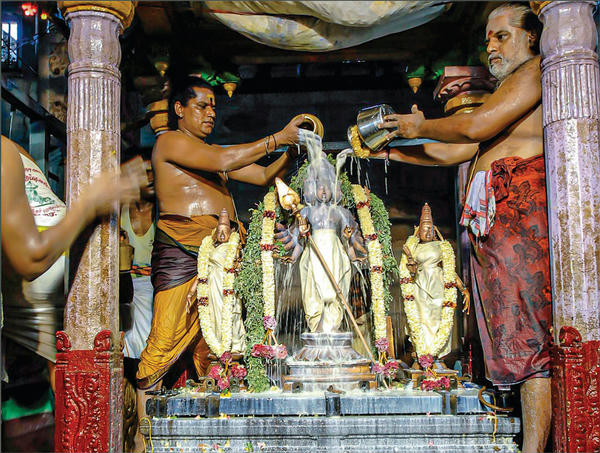
Holy oblations: Priests offer milk to the five-metal parade murti of Lord Shanmukha at the Tirupparankunram Temple near Madurai in Tamil Nadu

A satguru’s unequivocating insights on the Earth’s oldest living faith
FROM THE TEACHINGS OF SATGURU SIVAYA SUBRAMUNIYASWAMI
 eligion is man’s association with the Divine, and the ultimate objective of religion is realization of Truth. Forms which symbolize Truth are only indications; they are not Truth itself, which transcends all conceptualization. The mind in its efforts to understand Truth through reasoning must always fail, for Truth transcends the very mind which seeks to embrace it. Hinduism is unique among the world’s religions. I boldly proclaim it the greatest religion in the world. To begin with, it is mankind’s oldest spiritual declaration, the very fountainhead of faith on the planet. Hinduism’s venerable age has seasoned it to maturity. It is the only religion, to my knowledge, which is not founded in a single historic event or prophet, but which itself precedes recorded history. Hinduism has been called the “cradle of spirituality,” and the “mother of all religions,” partially because it has influenced virtually every major religion and partly because it can absorb all other religions, honor and embrace their scriptures, their saints, their philosophy. This is possible because Hinduism looks compassionately on all genuine spiritual effort and knows unmistakably that all souls are evolving toward union with the Divine, and all are destined, without exception, to achieve spiritual enlightenment and liberation in this or a future life. ¶Of course, any religion in the world is a mind stratum within people, isn’t it? It is a group of people who think consciously, subconsciously and subsuperconsciously alike and who are guided by their own superconsciousness and the superconsciousness of their leaders which make up the force field which we call a religion. It does not exist outside the mind. People of a certain religion have all been impressed with the same experiences. They have all accepted the same or similar beliefs and attitudes, and their mutual concurrence creates the bonds of fellowship and purpose, of doctrine and communion.
eligion is man’s association with the Divine, and the ultimate objective of religion is realization of Truth. Forms which symbolize Truth are only indications; they are not Truth itself, which transcends all conceptualization. The mind in its efforts to understand Truth through reasoning must always fail, for Truth transcends the very mind which seeks to embrace it. Hinduism is unique among the world’s religions. I boldly proclaim it the greatest religion in the world. To begin with, it is mankind’s oldest spiritual declaration, the very fountainhead of faith on the planet. Hinduism’s venerable age has seasoned it to maturity. It is the only religion, to my knowledge, which is not founded in a single historic event or prophet, but which itself precedes recorded history. Hinduism has been called the “cradle of spirituality,” and the “mother of all religions,” partially because it has influenced virtually every major religion and partly because it can absorb all other religions, honor and embrace their scriptures, their saints, their philosophy. This is possible because Hinduism looks compassionately on all genuine spiritual effort and knows unmistakably that all souls are evolving toward union with the Divine, and all are destined, without exception, to achieve spiritual enlightenment and liberation in this or a future life. ¶Of course, any religion in the world is a mind stratum within people, isn’t it? It is a group of people who think consciously, subconsciously and subsuperconsciously alike and who are guided by their own superconsciousness and the superconsciousness of their leaders which make up the force field which we call a religion. It does not exist outside the mind. People of a certain religion have all been impressed with the same experiences. They have all accepted the same or similar beliefs and attitudes, and their mutual concurrence creates the bonds of fellowship and purpose, of doctrine and communion.
The Joys of Hinduism
 onight we want to speak on the joys and happiness found in Hinduism, our ancient religion which brings forth the wonderful feelings of a belief in the cosmic processes of reincarnation coupled with knowledge of the laws of karma and the wisdom of dharma in which everyone has his rightful place and purpose in life. It brings the broadmindedness of total acceptance of all other religions as expressions of the One God’s creation, the blessing of a complete devotional path revolving around powerful temples, the fulfillment of a profound mystical teaching founded on yoga and brought forth by the seers and saints and gurus, and so much more. Our religion is so strong, so rich and varied that very few can claim to understand it in its completeness. It is immense, an immense religion, so immense that we have difficulty sometimes explaining it to those who hold to a simpler doctrine, especially if they have been subjected to erroneous concepts about our religion promulgated by invaders and missionaries of a score of alien religions. It is time that the world knew of the greatness of Hinduism, knew it as it is. Of course, we cannot explain it in an evening. My satguru, the great Siva Yogaswami of Columbuthurai, would say, “The time is short and the subject is vast.” But we can have a look at some of the aspects of Hinduism that bring such joys and happiness to over a billion devotees around the world. ¶Each Hindu’s belief in reincarnation is so strong that it totally eliminates the fear and dread of death. No true Hindu really fears death; nor does he look forward to it. The word death in the vocabulary of the Hindu holds a different meaning. He does not take death to be the end of existence; nor does he look upon life as a singular opportunity to be followed by eternal heavenly existence for those souls who do well, and by unending hell for those who do not. Death for the Hindu is merely transition, simultaneously an end and a new beginning. Over two thousand years ago, Saint Tiruvalluvar wrote, “Death is like falling asleep, and birth is like awakening from that sleep” (Tirukural 339). In one of the ancient languages of our religion, the physical body had a name which literally meant “that which is always dropping off.” ¶The Hindu’s knowledge of reincarnation gives him the hope of attaining a future birth and in that birth making further progress toward the perfection that he intuitively knows is his atman, his soul. He is working in this life to gain enough good merit, enough punya, to deserve welcome into a fine religious family as a good soul that will not upset the family but add to its love and harmony and productivity. That is one aim ever on the mind of the devout Hindu, to live well that he may live even more perfectly in a future life on this planet. That is our aim; and our other beliefs, our accumulated knowledge and the many facets of our religion, give us the strength and the wisdom to believe in such a far-reaching way, to look beyond the immediate day-to-day concerns into our ultimate objective, which is realization and liberation, moksha. ¶Nor is this belief in the cycles of earthly existence, in reincarnation, merely a belief. It is a certain knowledge for those who have had even a tiny glimpse into their origins to the point of remembering another life or just intuiting that the soul did not come into existence just before one’s birth. The Hindu believes that the soul undertakes many sojourns on the planet. We see the wisdom in this cycle of birth, death and rebirth.
onight we want to speak on the joys and happiness found in Hinduism, our ancient religion which brings forth the wonderful feelings of a belief in the cosmic processes of reincarnation coupled with knowledge of the laws of karma and the wisdom of dharma in which everyone has his rightful place and purpose in life. It brings the broadmindedness of total acceptance of all other religions as expressions of the One God’s creation, the blessing of a complete devotional path revolving around powerful temples, the fulfillment of a profound mystical teaching founded on yoga and brought forth by the seers and saints and gurus, and so much more. Our religion is so strong, so rich and varied that very few can claim to understand it in its completeness. It is immense, an immense religion, so immense that we have difficulty sometimes explaining it to those who hold to a simpler doctrine, especially if they have been subjected to erroneous concepts about our religion promulgated by invaders and missionaries of a score of alien religions. It is time that the world knew of the greatness of Hinduism, knew it as it is. Of course, we cannot explain it in an evening. My satguru, the great Siva Yogaswami of Columbuthurai, would say, “The time is short and the subject is vast.” But we can have a look at some of the aspects of Hinduism that bring such joys and happiness to over a billion devotees around the world. ¶Each Hindu’s belief in reincarnation is so strong that it totally eliminates the fear and dread of death. No true Hindu really fears death; nor does he look forward to it. The word death in the vocabulary of the Hindu holds a different meaning. He does not take death to be the end of existence; nor does he look upon life as a singular opportunity to be followed by eternal heavenly existence for those souls who do well, and by unending hell for those who do not. Death for the Hindu is merely transition, simultaneously an end and a new beginning. Over two thousand years ago, Saint Tiruvalluvar wrote, “Death is like falling asleep, and birth is like awakening from that sleep” (Tirukural 339). In one of the ancient languages of our religion, the physical body had a name which literally meant “that which is always dropping off.” ¶The Hindu’s knowledge of reincarnation gives him the hope of attaining a future birth and in that birth making further progress toward the perfection that he intuitively knows is his atman, his soul. He is working in this life to gain enough good merit, enough punya, to deserve welcome into a fine religious family as a good soul that will not upset the family but add to its love and harmony and productivity. That is one aim ever on the mind of the devout Hindu, to live well that he may live even more perfectly in a future life on this planet. That is our aim; and our other beliefs, our accumulated knowledge and the many facets of our religion, give us the strength and the wisdom to believe in such a far-reaching way, to look beyond the immediate day-to-day concerns into our ultimate objective, which is realization and liberation, moksha. ¶Nor is this belief in the cycles of earthly existence, in reincarnation, merely a belief. It is a certain knowledge for those who have had even a tiny glimpse into their origins to the point of remembering another life or just intuiting that the soul did not come into existence just before one’s birth. The Hindu believes that the soul undertakes many sojourns on the planet. We see the wisdom in this cycle of birth, death and rebirth.
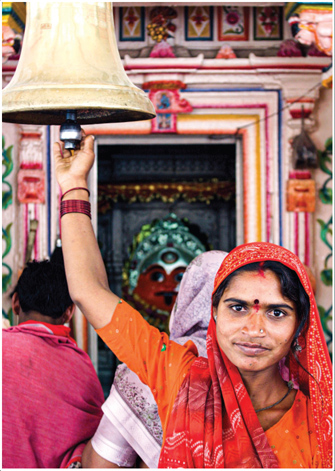
THOMAS KELLY
Clockwise: The Porram Festival in Thrissur, Kerala, led by 15 gold-caparisoned elephants

PHAL S. GIROTA
Clockwise: A woman rings the bell as she enters the Gadhikalika temple in sacred Ujjain city, signalling her presence to the angelic hosts
Karma Is Always Just: We see reincarnation as an explanation for many of the apparent inequalities observed in life. Thus we understand the fairness even in a bad birth, say a birth as a cripple or a child who dies in infancy. To the Hindu this is not an accident, but is a natural event brought forth by the soul itself through the karma of unseemly acts and desires in a previous life. To the Hindu there is not one force in the universe at work to make all things good and an opposing force trying to destroy the soul. No. All is God’s work. All karma is natural and worthy of the soul to which it comes. ¶The Hindu knows that it is the younger souls who lack understanding, who cannot live in harmony with others and who shun the higher forms of culture and faith. Rather than inheriting eternal suffering for their acts, they earn instead another opportunity for experience, for learning, for evolving. The ideas of sin and evil are different in Hinduism from the concepts held by Abrahamic religions. If there is such a thing as sin to the Hindu, it is the breaking of the natural laws, a lapse in the patterns of karma and dharma, and that transgression brings its own punishment in the form of an additional karma created to then be worked out. Thus the Hindu does not live in fear of sin or under the notion of original sin. We do not look upon humanity as inherently sinful, but inherently perfect and striving to unfold that perfection from within. The Hindu knows that we will have as many opportunities as needed to refine and evolve our nature—a thousand lives or more if needed. We don’t have to think that we only have a single chance, a one life in which everything must be accomplished and all desires must be fulfilled. Therefore, we are not in a hurry. We are patient. We exhibit more patience with circumstances than do those who believe in a one life, and we are more forgiving of ourselves when we fall short. Thus it is that Hinduism offers a great joy to its followers—a blessing of fearlessness in the face of death, an assurance of the continuation of consciousness after physical death, another assurance that each soul creates its own karma and that such karma is just and right, even when it seems that some people are less fortunate than others and that fate has unfairly given all the advantages to a few. All these things are bestowed on Hindus simply because they understand the doctrine of reincarnation. ¶Hinduism is a hopeful and comforting religion. Hope for a future life makes this life worthwhile, joyous, contented and happy, because the Hindu can live and deal with current problems knowing that they are transitory problems, that they will not last forever; nor will they affect us forever. They are problems; we cannot deny that. But they are problems to be worked out with a positive attitude and a high energy and a helping hand from our Gods.
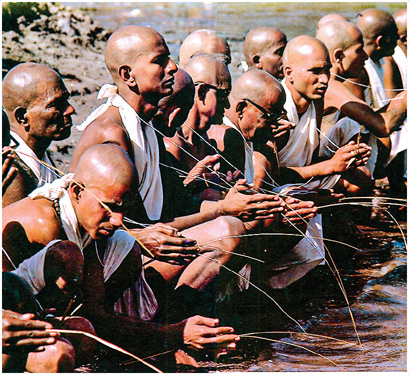
THOMAS KELLY
Sacred omnipresence: Pilgrims touch the silver sandals at a guru shrine in Northern Sri Lanka
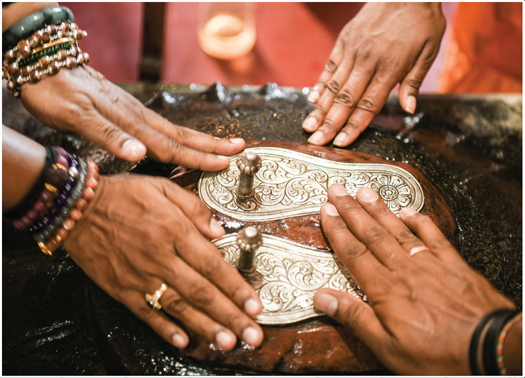
RAJKUMAR MANICKAM
Sacred omnipresence: Shaven-headed aspirants await the auspicious moment of brahmachari (celibacy) initiation and entry into an order of world-renouncing sadhus
The World as Our Teacher: The Hindu also wants to improve conditions in the world, in the physical world. We do not look upon all that happens to us as unreal. That is a misconception. It is real. Life is real. It is through life that we progress. Life is the means provided by the Primordial God for finding Reality. True, it is maya. But it is maya in the form of mind, in the form of form. Maya, or form, or mind, is created for a purpose, to help man evolve, not to bind him in illusion. The Hindu understands this. We want to help humanity, and simultaneously we know that we may well return in another physical body. So we are working not only for ourselves, but for our loved ones, not only now, but in the future as well. We are improving the world for future generations in which we will play a part. ¶Through our knowledge of reincarnation, we have a great love and understanding for every human being, for they have been our mothers, our fathers, our sons and daughters, our grandparents and companions in many past lives, or perhaps will be in a future incarnation. This expanded knowledge of the interrelatedness of humanity brings with it a deepened appreciation, helping us to understand why it is that some people seem so close to us though we hardly know them and others are strangers or even enemies after years of close association. To the Hindu, everyone younger is his brother or sister. Everyone older is his mother or father, and he maintains a deep respect for others. We have this knowledge by having lived through many hundreds of lives on this planet and having been associated with many thousands of people. We know that in our current pattern in this life we often attract those to us whom we have been with in past lives. So we have a great joy and happiness in meeting them again and a deep knowledge of our relationships, our psychic relationships, with them in past lives. ¶The Hindu believes in the law of karma, the ability to earn one’s rewards as well as punishments. All this we can do ourselves with the help of our Gods and our personal relationship with our Ishta Devata, the individual God that we have chosen, or rather that God who has chosen to love, guide and protect us through an incarnation. ¶In Hinduism, there is no priest standing between the devotee and God. The priest is a servant of the God, just as is every other devotee. Even the satguru, the spiritual teacher, does not stand between the disciple and God, but seeks instead to strengthen the devotee’s direct experiential relationship with the Divine. The Hindu thus finds a great joy in his relationship with God and the Gods. It is his relationship, and he alone is able to perpetuate it. No one can do this work for him or on his behalf. There is a great happiness there between the devotee and the God resident in the Hindu temple, which is the communication point with the God, as is the sacred home shrine.

HIMALAYAN ACADEMY
Community worship: Women in India perform the sadhana of counting mantrams on the beads of their concealed malas
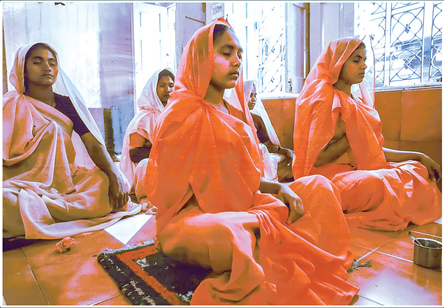
THOMAS KELLY
Community worship: A bronze of Siva as Sadasiva, with five faces and ten arms holding symbols of his cosmic powers
The Joy of Pilgrimage: In our religious life, one of the most fulfilling aspects is pilgrimage. We have a joy in looking forward to a spiritual journey, and we experience a contentment while on our pilgrimage and later bask in the glowing aftermath of the pujas. It is like going to see a great friend, a devotee’s most loved friend—the Ishta Devata. We travel to the far-off temple where this great friend is eminently present. At that particular temple, this personal God performs a certain function, offers a specific type of blessing to pilgrims who make the pilgrimage to that home. In this way, different temples become famous for answering certain types of prayers, such as requests for financial help, or prayers for the right mate in marriage, prayers to be entrusted with the raising of high-souled children, or help in matters of yoga, or help in inspiring bhakti and love. ¶The Hindu does not have the feeling of having to take a vacation to “get away from it all.” We don’t lead a life of mental confusions, religious contradictions and the frustrations that result from modern hurried living. We lead a moderate life, a religious life. In living a moderate life, we then look at our pilgrimage as a special moment, a cherished time of setting ordinary concerns aside and giving full stage to our religious longings. It is a time to take problems and prayers to our personal God. ¶Unlike the proud “free thinkers” who deem themselves emancipated, above the religious life, we Hindus feel that receiving the darshana from the Gods and the help that comes therein invigorates our being and inspires us to be even more diligent in our spiritual life. Unlike the rationalists who feel confident that within themselves lie all the resources to meet all needs, and that praying to Gods for help is a pathetic exercise in futility, the Hindu wisely submits to the Divine and thus avoids the abyss of disbelief. ¶All in life that one would want to “get away from” the Hindu takes with him on a pilgrimage to the temple, to the feet of his personal God, to the inner-plane being or Mahadeva, who needs no physical body with which to communicate with people—to the God who has a nerve system so sensitive and well developed that as it hovers over the stone image, which looks similar to how the Deity would look on the inner planes, this being of light can communicate with the pilgrims who visit the temple. This being of light, this Mahadeva, can and does absorb all of the dross the devotees have to offer, and gives back blessings which bring happiness and release to them. Thus, the pilgrimage is not travel in the ordinary sense of travel, but rather going to see a personal friend, one who is nearest and dearest, but does not live in a physical body. ¶The Hindu has another great joy—the certainty of liberation. Even in difficult times, we are solaced in the knowledge of our religion which tells us that no soul that ever existed or ever will exist in future extrapolations of time and space will ever fail to attain liberation. The Hindu knows that all souls will one day merge into God; and he knows that God, who created all souls, slowly guides our maturing into His likeness, brings us back to Himself, which is not separate from ourselves. The Hindu, through striving and personal development in this life on this planet, knows that liberation into God is the final goal. This knowing and this belief release us from any ego, from any superiority by which one person considers himself or herself as especially meriting God’s grace while others are lost. For the Hindu, there is an assurance that all souls will eventually enjoy liberation, and that includes ourselves and all of our friends and family. We need never fear otherwise.

THOMAS KELLY
Pilgrimage: An exuberant crowd showers turmeric powder, coloring everyone in the yellow kinship of devotion during the festival of Holi
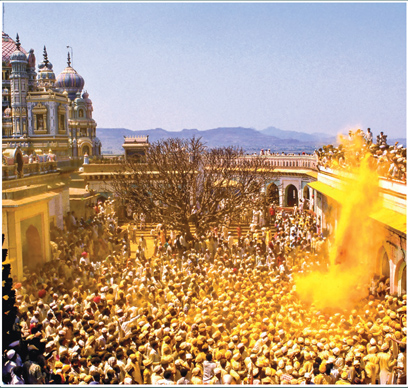
THOMAS KELLY
Pilgrimage: Women at a marketplace in Nepal.
The Joy of Mysticism: Then there is the joy of the mysticism of Hinduism. It is the world’s most magical religion, offering worlds within worlds of esoteric discovery and perception. The inner worlds are what Hindu mystics tell of in the greatest richness and freedom of expression that exists on the planet. Mysticism in Hinduism is more out-front than in all the other religions of the world. As a result, it is enjoyed by more of the people in our religion. Mysticism is discussed more broadly and not limited to a few great souls or a handful of pandits. The mysticism of Hinduism is for all the people; yet, too, in its esoteric aspect it is protected at its core and kept sacred by being kept secret. How grand is the Hindu mystical tradition, with its sadhanas and yogas, with its wealth of understanding of the etheric bodies, of the nadis and the chakras, of the aura and the pranas, of the various states of consciousness and levels of existence, and so much more. No other religion on the Earth can ever begin to equal Hinduism’s mystical teachings; all that wealth is the rightful inheritance of each Hindu. ¶The Hindu enjoys all the facets of life as transmuted into a religious expression in art. The Hindu’s art is a religious art—drawing, painting and sculpture of the Gods, the devas, and the saints of our religion. The music is devotional and depicts the tones of the higher chakras, echoes the voices of the Gods; and the dance emulates the movements of the Gods. We are never far away from sights, sounds and symbols of our religion. A mountaintop represents Lord Siva; a hill represents Lord Murugan, Karttikeya; and sugarcane fields represent Lord Ganesha. Everything that one sees on the planet represents something religious. Art is not merely for egotistical and existential self-expression, but for spiritual expression, done consciously in service to the Divine. That is why one seldom sees or even knows the name of the artist of the great Hindu artistic creations. The artist is not creating in order to become famous or rich. He is surrendering his talents, serving his Gods and his religion through his art, and his art takes on a certain sacredness. ¶One great joy that the Hindu has is the appreciation for all other religions. Hinduism is theocentric, that means God-centric; whereas most other religions are prophet-centric, revolving around the personality of some living person or some person who once lived in history and interpreted religion to his culture in his time. Hinduism has no founder. It was never founded. It has neither a beginning nor an end. It is coexistent with man himself. That is why it is called the Sanatana Dharma, the Eternal Path. It is not one man’s teaching or interpretation. It is not limited to a single facet of religion, but consists of the entire spectrum, seen in its various components as if through a prism. It does not say that this religion is wrong and this one right. It sees God everywhere, manifesting all the great religions. The Hindu can appreciate Buddha without becoming a Buddhist. He can understand Jesus without becoming a Christian. Therefore, the joys of all the religions of the world become the joys of the Hindu. ¶But as Hindus, we must first think of the joys and happiness within our own religion. Consider our blessings. Come closer to the Gods of our religion. The many Gods are in the Western world now and have circumferenced the planet with their shakti of radiant rays that penetrate with spiritual power, bringing harmony and culture, balancing out the dharma of the planet. ¶Hinduism is such a great religion. All practicing Hindus are very proud of their religion. Unfortunately, these days too many born into the religion are not all that proud to be Hindus, but this is slowly changing. Hindus are now welcoming into their religion others who are, of their own volition, adopting or converting into the Sanatana Dharma. They are proud enough of their faith to want others to share its wisdom, its mysticism, its scriptures, its broadmindedness, its magnificent temples and its final conclusions for all mankind. To all Hindus, who today are found in every country on the Earth, I say: Courage! Courage! Courage! Have the courage to know beyond a doubt that Hinduism is the greatest religion in the world. We must be proud of this.
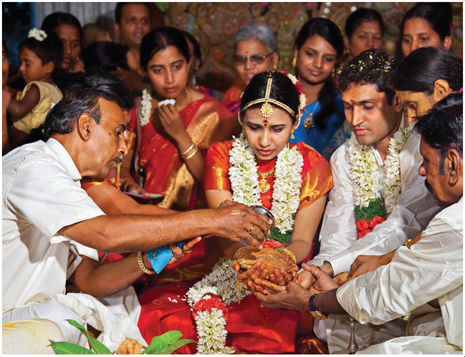
Lavish ceremonies: A couple walk barefoot in the precincts of the Sri Ekambaranathar Siva Temple in Kanchipuram, Tamil Nadu
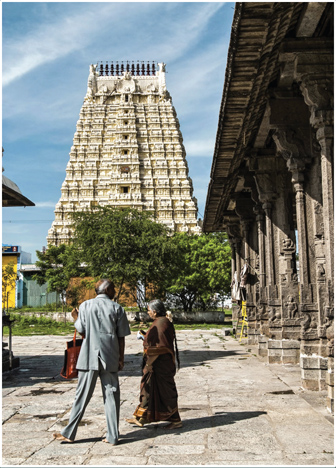
THOMAS KELLY
Lavish ceremonies: A bride and groom are joined in matrimony through the multi-day vivaha samskara
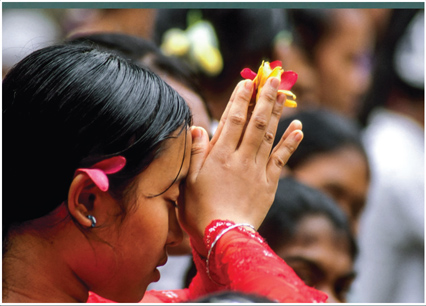
THOMAS KELLY
Seeing God in all: During the Raksha Bandhan festival, a girl ties a woven bracelet on her brother’s wrist. It betokens her love and prayers for his welfare, and his commitment to protect her
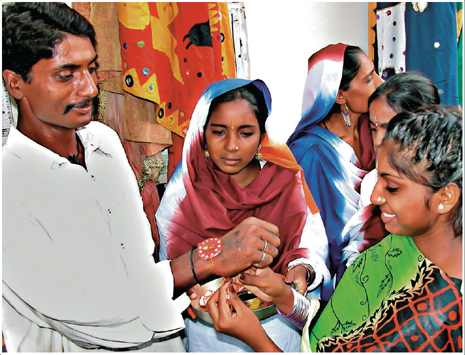
HINDUISM TODAY
Seeing God in all: A worshiper holds hands in anjali mudra, gesturing love and adulation for the Deity.
Hinduism Cannot Be Destroyed: It is false to think that one has to be born a Hindu in order to be a Hindu. That is a concept postulated by certain caste-based Hindu lineages and reinforced by the Christians in their effort to hinder the growth of our religion, to deprive it of new life, to hold it down while they in turn try to convert Hindus en masse to their religion. Swami Vivekananda (1863–1902), a Hindu monk and missionary who wrote extensively on the Hindu Dharma, when confronted by this same issue in the West would explain how Hindus who have been converted by force should not be denied an opportunity of returning to their ancestral religion. As for the case of those not born into Hinduism who might be interested to join it, he simply said, “Why, born aliens have been converted in the past by crowds, and the process is still going on.” Dr. S. Radhakrishnan (1888–1975), the distinguished Hindu philosopher who became the second president of India, confirms this view in writing, “In a sense, Hinduism may be regarded as the first example in the world of a missionary religion. Only its missionary spirit is different from that associated with the proselytizing creeds. It did not regard as its mission to convert humanity to one opinion. For what counts is conduct and not belief. The ancient practice of vratyastoma, described fully in the Tandya Brahmana, shows that not only individuals but whole tribes were absorbed into Hinduism.” ¶During the era of India’s domination by alien religions, when Hinduism was scheduled to be destroyed, the attack was to be carried out in three ways. The first strategy was to convince the women to abandon their age-old stri dharma—of maintaining the home, its purity and ways of worship—thus drawing them away from the household in order to receive a so-called “higher education” or to teach in alien religious schools, thus denying future generations the mother’s religious counsel and grounding in the dharma. The second strategy was to overtly break down the various castes of temple priests by enticing them to accept other, often higher paying, occupations, thus leaving the temples unattended. ¶The third strategy was to convince Hindus that they had inherited a crude and outdated religion. This last attack was accomplished mainly through ridicule, by ridiculing every aspect of the religion that could possibly be ridiculed. For example, those who slandered Hinduism claimed it has no sacraments. Why, Hinduism has more sacraments, more sacred rites and ceremonies for its members, than perhaps any other religion in the world. These sacraments include the namakarana samskara, name-giving sacrament; annaprashana, first feeding; karnavedha, ear-piercing; vidyarambha, commencement of learning; vivaha, marriage; and many others. ¶Though India was politically dominated for generations by adherents of alien faiths, and though every attempt was made to discourage, weaken and crush the native religion, the carefully calculated, systematic assault failed to destroy Hinduism. Hinduism cannot be destroyed. It is the venerable eternal religion, the Sanatana Dharma. But it was an effective campaign that has left in its wake deep samskaric patterns, deep subconscious impressions, which still persist in the minds of the Indian people. It is going to be difficult to completely eradicate these impressions, but with the help of all the millions of Hindus throughout the world, in adhering to and extolling the benefits and joys of Hinduism and the gifts which it holds for mankind, this is possible and feasible, within the range of accomplishment, perhaps within this very generation.


SUNDER RAJ
Raising Youth: Hindu school girls in Bengaluru, India

SAT SAHITYA PRAKASHAN TRUST
Raising Youth: Boys attending Rameshbhai Oza’s Hindu school at Sandipani Vidyaniketan near Porbandar, Gujarat
Bringing in Ardent Seekers: Hindus should freely welcome sincere devotees into their religion, not those who already have a firm religion and are content, but those who are seeking, who believe, as millions in the West already believe, in the laws of karma and reincarnation and the existence of the ever-present God that permeates this planet and the universe. Hindus should freely embrace those who believe in the Gods and all we have been speaking about earlier, for whom other religious avenues have proved empty and fruitless. There are certain matured souls for whom the Sanatana Dharma can be the only true religion, who have no other religion and who will seek and seek until they come upon its profound truths, perhaps in an old scripture, or in a temple sanctum during puja or in the eyes of an awakened siddha yogi. These souls we must help. We must teach them of our religion and allow them to fully accept or reject it, to accept it because they know it, or to reject it because they know it and are not ready to meet Maha Ganapati and humbly sit at the feet of this most profound Lord. ¶There are many lost souls on the planet today who die in the physical world—lose their physical body—wander on the astral plane a short time and are caught up immediately in another womb. They have no knowledge of other states of existence or of the workings of reincarnation. They have no time for the bliss of these in-between, astral states. They have no time for assessing their last life and preparing for the next, which they could then enter with new knowledge, no time for inner attunement with the Gods in the inner worlds between death and birth. Instead, they are caught in a constant cycle of flesh, making flesh and living in flesh, with the soul being immersed in ignorance and the darkness of the consciousness of flesh. Hinduism eradicates this cycle by offering knowledge of the states between life and death and then life again. It creates deep impressions within the mind of these individuals, which then bring them out of this syndrome so that they can enjoy months, years, in fact, of education and knowledge in the inner planes of consciousness between births, so that they can come back into a physical body a more awakened soul than when they left their last physical sheath at death. ¶We must not be reluctant to welcome these sincere Hindu souls and to assist them in finding the answers they seek and do not find elsewhere. It is our dharma to help them. Hinduism has always welcomed adoptives and converts. Bring in new people to the religion. Teach them. Help them. Counsel them. Proceed with confidence. Have courage, courage, courage.
